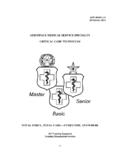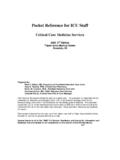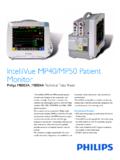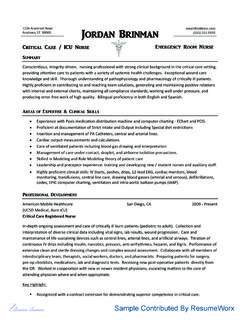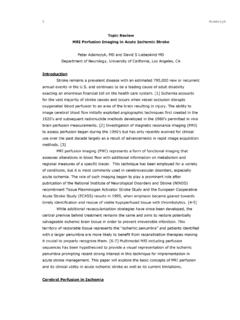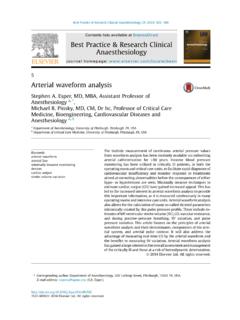Transcription of The ins and outs of hemodynamic monitoring
1 Essentials The ins and outs of hemodynamic monitoring KELLI ROSENTHAL, RN,BC, APRN,BC, CRNI, MS. President and Chief Executive Officer Oceanside, EVEN IF YOU AREN'T a critical care The primary purpose of invasive hemody- nurse, you should understand the vascular namic monitoring is to detect and monitor We've got to access devices used in the invasive hemo- changes in intravascular pressures and car- keep this guy dynamic monitoring of critically ill or un- diac output, which allows for optimum under stable patients. Let's learn what they're all patient management. With invasive hemo- constant about. dynamic monitoring , specialized catheters, pressure. intravenous ( ) tubing, and instruments What's hemodynamic are inserted into the vascular system to mea- monitoring ? sure pressures. The term hemodynamic relates to blood circula- Making waves tion. What that means is Most invasive hemodynamic monitoring that hemodynamic mea- systems work pretty similarly, and they surements describe the in- usually have three components: a trans- travascular pressure and ducer, an amplifier, and a recorder/monitor.
2 Flow occurring when the The transducer converts the fluid waves heart muscle contracts generated by blood flow into electrical sig- and pumps blood nals that are presented numerically by throughout the body via electronic monitoring equipment. The am- the vascular system. plifier, which increases the size of the sig- The heart (a pump), blood nal from the transducer, is located inside (volume for the pump to move), the bedside monitor. A recorder or moni- and vascular tone (resistance tor displays the signal and records infor- against the pump) are the three mation. elements that combine to keep Other hemodynamic monitoring equip- the vascular system in work- ment is needed as well. For example, only ing order. hemodynamic semi-rigid pressure tubing can be used;. measurements relate the sta- changes in pressure from tubing distention tus of these elements. would cause inaccurate readings. This tub- Both invasive and nonin- ing has an intraflow flush device to maintain vasive techniques can be patency of the catheter tip, as well as a man- used to determine a ual flush device to flush out air bubbles and patient's hemodynamic to rapidly flush the line after blood sam- status.
3 Every time you pling. take a patient's blood The tubing is connected to an infusion pressure, you're using a bag, which usually contains a heparin solu- noninvasive hemodynamic monitoring tion of 1,000 units in 500 ml of sodium device. It helps you determine three hemo- chloride. The bag is placed inside an inflated dynamic parameters: the systolic, diastolic, pressure bag to maintain a constant pres- and mean pressures (using the systolic and sure usually 300 mm Hg within the line. diastolic pressures to calculate the mean This prevents arterial blood from backing up pressure). into the pressure tubing. The transducer is 6 Nursing made Incredibly Easy! July/August 2004. kept at the level of the right atrium, usually The pressure's on on an pole. The central venous pressure (CVP) is a measurement of the pressure in the right The offensive line atrium, which reflects the relationship Let's look at the most common invasive among cardiac action, vascular tone, and devices used to assess hemodynamic sta- blood volume.
4 CVP isn't an accurate re- tus arterial lines, central venous pressure flection of left ventricular function, catheters, and pulmonary artery catheters. though. Arterial lines are a low-risk, reliable CVP is usually measured in patients for method for continuously monitoring sys- whom fluid balance is a concern. On the temic arterial blood pressure. They allow basis of the CVP readings, the health care serial blood sampling, which eliminates provider can make more accurate decisions repeated painful arterial needle sticks for about fluid replacement or restriction. The arterial blood gas (ABG) evaluations. They normal CVP reading is to 2 to 6 mm Hg. can also evaluate the high-pressure blood Decreased CVP indicates low circulating vol- flow pulsations generated by contraction of ume; elevated CVP indicates fluid overload. the heart, converting the pulsations to a dis- A single- or multilumen CVP catheter tinctive waveform on the monitor.
5 This may be inserted through the internal jugular should correlate with the patient's electrocar- or subclavian vein, with the tip advanced diogram. into the superior vena cava. A CVP inserted A peripheral infusion catheter is inserted into the femoral vein resides in the inferior into an easily accessible artery, such as the vena cava. radial, brachial, or femoral artery, after arter- The pressure monitoring assembly is usu- ial blood flow to the extremity is verified. ally attached to the distal port of a multilu- The catheter is secured by sutures or a sterile men central venous catheter. Other lumens securement device. Because arterial lines are may be used for rapid infusion for fluid vascular access devices, they require the replacement in shock, infusion of hypertonic same nursing care provided to any central solutions and medications that could dam- catheter, such as sterile dressing changes and age veins, and serial venous blood assess- flush bag and tubing changes every 72 to 96 ment.
6 Hours. Follow your institution's policy for sterile The most frequent complication of arterial CVP line care, including flushing and dress- lines is thrombosis. Because the risk of ing changes. Unused lumens must be thrombosis increases the longer the arterial flushed at manufacturer-recommended line remains in place, the insertion site is intervals to avoid thrombotic complications, rotated every 72 to 96 hours at many institu- which can lead to catheter-related blood- tions. The usual rate of catheter-related stream infection. Temporary central venous bloodstream infections from a radially catheters have the highest risk of catheter- placed arterial line is 1% to 2%. Infection related bloodstream infection, so keep the rates rise when a cut-down insertion tech- system closed and change dressings, caps, nique is used for sites other than the radial and tubings at the recommended intervals. artery the most common site for an arterial Sterile techniques must be used for CVP line line insertion and with previous infection care.
7 From other sources. Never tie off clotted lumens; a clot is a Other potential complications include skin breeding ground for bacteria. Clear the breakdown under the transducer set at the lumen with an approved thrombolytic agent catheter hub, excessive bleeding from the (such as alteplase [Cathflo Activase]) or insertion site or from the system itself if the exchange the catheter; remove the catheter if line is disconnected, air embolism from it's no longer needed. purging air into the patient, and ischemia Other potential complications of CVP. distal to the insertion site, should arterial lines include pneumothorax (on insertion), flow become compromised. excessive bleeding, arterial puncture, July/August 2004 Nursing made Incredibly Easy! 7. essentials catheter malposition, cardiac tamponade, artery. A small syringe is attached to one Rapid fluid cardiac arrhythmias, deep vein thrombosis, port, and it's used to inflate the balloon.
8 This infusion via a air embolism, and catheter embolism. is done only to allow the tip of the catheter to CVP catheter As you remove the CVP line, don't cut the float from the pulmonary artery into a pul- can save the catheter when taking out the sutures. Have a monary capillary, known as wedging the day for a sterile, occlusive, pressure dressing ready to pressure. When the catheter tip goes as far as patient in cover the site to prevent excessive bleeding it can, pulmonary capillary wedge pressure and air embolism. Ask the patient to bear (PCWP) can be measured. The PCWP. shock. down while you remove the catheter. You reflects the pressure within the left atrium. can also remove the catheter as the patient The balloon is deflated as soon as PCWP is exhales. Depending on your institution's obtained. Look at the number and waveform policy, you might use petrolatum gauze to make sure the catheter isn't still wedged. or apply antimicrobial ointment to the The pressures measured by the PA catheter dressing to seal the catheter tract.
9 Can be used for other hemodynamic calcula- tions, such as systemic vascular resistance Let's multitask! (SVR) and cardiac index (CI). The pulmonary artery (PA) Another feature of the PA catheter is a catheter has several functions, in- crinkly, plastic sheath that covers a portion cluding measuring CVP, mea- of the external catheter. This sheath main- suring pressure in the pul- tains sterility of the catheter as it's ad- monary artery, and reflecting vanced through the heart, so it shouldn't be the pressure in the left atrium. removed. At most institutions, the catheter It also allows for hemody- can't be advanced after the first 24 hours namic calculations, such following insertion. Chest X-rays must be as cardiac output. done to verify PA catheter placement and Routine use of PA lines is to ensure that the patient doesn't have a controversial because of associ- pneumothorax. ated risks and costs. Many opponents Like other central catheters, the PA line believe the lines should be reserved for the must be covered with a sterile dressing most critically ill patients.
10 According to your institution's protocol. The Typically, PA lines are inserted through a dressing, all caps applied to the catheter single-lumen introducer placed in the inter- lumens, and the pressure monitoring setups nal jugular or subclavian vein. The PA must be replaced at the intervals specified by catheter slides through the introducer your institution's policy. Your institution diaphragm, then is threaded through the may follow the Centers for Disease Control right atrium and right ventricle and into the and Prevention's guidelines, which recom- pulmonary artery. The introducer mend that tubing be replaced every 96. diaphragm prevents air from getting into the hours. Although you may be tempted, don't bloodstream. pin or tape the PA line to your patient's gown in an effort to prevent its accidental A league of their own dislodgment. The patient could end up PA lines are longer and have more ports pulling on the line as he moves.


